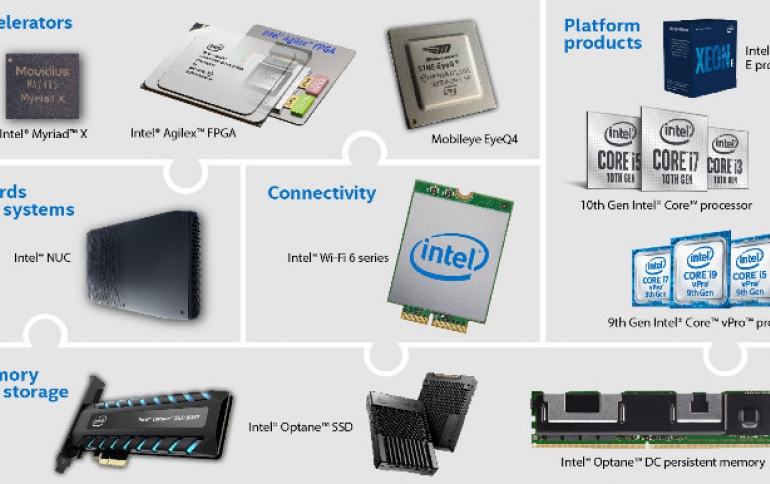
Intel Expects Second-Gen 3D XPoint to Launch Next Year
Intel's annual report (2019) suggests that the company’s second-generation 3D XPoint products – Alder Stream and Barlow Pass – might be delayed until 2021.
Intel announced last September its second-generation 3D XPoint and provided a roadmap into the future. ,The second-generation 3D XPoint memory features four layers of the memory, as opposed to two layers in the first generation. Intel has also talked about significant performance gains.
Intel's 'Barlow Pass' is the second-generation Optane DC persistent memory and 'Alder Stream' is a new Optane DC SSD. Intel's roadmap indicated that the products would launch together with the Whitley platform, which will see Cooper Lake in the first half of the year followed by Ice Lake at the end of the year.
However Intel’s annual report suggests that those products might not be released in 2020 at all. Here is what Intel says:
"With our Intel 3D NAND technology and Intel Optane™ technology, we are developing products to disrupt the memory andstorage hierarchy. The 4th generation of Intel-based SSDs are scheduled to launch in 2020 with 144-layer QLC memory technology. These SSDs are also Intel’s first NAND memory technology created independently by Intel since the conclusion of our partnership with Micron Technology, Inc. (Micron). The 2nd generation Intel Optane SSDs for data centers are scheduled to start shipping samples in 2020, and are designed to deliver three times the throughput while reducing application latency by four times. In addition, the second-generation Intel Optane DC persistent memory is expected to achieve PRQ in 2020, and is designed for use with our future Intel Xeon CPUs."
On the process technology and manufacturing side, Intel's CFO George Davis repeated what the company already said in its latest financial result Q&A session:
"Our 10nm manufacturing process entered full production as we launched (2019) our first products from this advanced technology. We are accelerating the pace of process node introductions and moving back to a 2- to 2.5-year cadence. We are on track to deliver our first 7nm-based product, a discrete GPU, at the end of 2021. 5G continues to be a strategic priority, and our exit from the 5G smartphone modem business is enabling us to increase the focus of our 5Gefforts on the opportunity to modernize network and edge infrastructure."
Intel also discussed the shortages and the role of the design rules for 7nm.
The company explained why the 25% increase in 14nm wafer capacity merely resulted in a low double-digit (10-15%) increase in PC supply. Intel attributed this to higher model volume, larger die sizes and more 14nm chipsets:
“We increased our wafer capacity [by 25%] during 2019; however, we did not see a commensurate increase in client CPU unit as wafer capacity was largely consumed by increases in modem and chipset volumes, and unit die sizes.”
Concerning process technology, Intel highlighted the company’s efforts to reduce the amount of design rules:
“We are also pursuing [a 4x] design simplification to accelerate innovation, including a significant reduction of design rules for future process nodes, to allow us to deliver the best solutions for our customer.”
"We announced (2019) that we are planning multiple waves of 10nm process, progressively increasing transistor performance. We also announced advances in our next-generation 2.5D (EMIB) and 3D (Foveros) packaging technology which will enable us to mix and match chips made on different processes into a single SiP, enabling new design flexibility and new device form factors. The Intel 10nm product era is underway, as we began shipping our new 10th generation Intel Core processors, previously referred to as Ice Lake. We are designing products for four major computing architectures—CPU, GPU, AI accelerator, and FPGA products—as we move toward a model of providing multiple "xPU" compute platforms for a more diverse era of computing. We shipped the 10th generation Intel Core processors with our next-generation CPU microarchitecture, which has architectural extensions designed for special-purpose computing tasks such as AI and cryptography, among other features. These processors also include the next generation of graphics microarchitecture, with performance and feature upgrades. We also continue to make progress on the development of our first discrete GPU."
We improved our 10nm factory production, yield, and volume during 2019, and launched 10th-generation Intel Core processors, our first 10nm volume product, and Intel Agilex, our first 10nm FPGA. We expect to deliver initial production shipments of our first 10nm-based Intel Xeon Scalable product, Ice Lake, in the latter part of 2020. We are on track to deliver our first 7nm-based product, a data center-focused discrete GPU, at the end of 2021. We are approaching next-generation process nodes with a focus on striking an optimal balance between schedule, performance, power, and cost and will continue to drive intra-node advancement."
Intel also discussed the recent acquisition of Habana Labs:
"Habana's Gaudi AI training processor is currently sampling with select hyperscale customers. Large-node training systems based on Gaudi are expected to deliver up to four times increase in throughput versus systems built with the equivalent number of GPUs. The acquisition strengthens our AI portfolio and accelerates our efforts in the nascent, fast-growing AI silicon market."
Interestingly, Intel mentions the Gaudi accelerator (and not Goya for inference), could indicate that Intel was mostly interested in Habana’s accelerator for training.





















